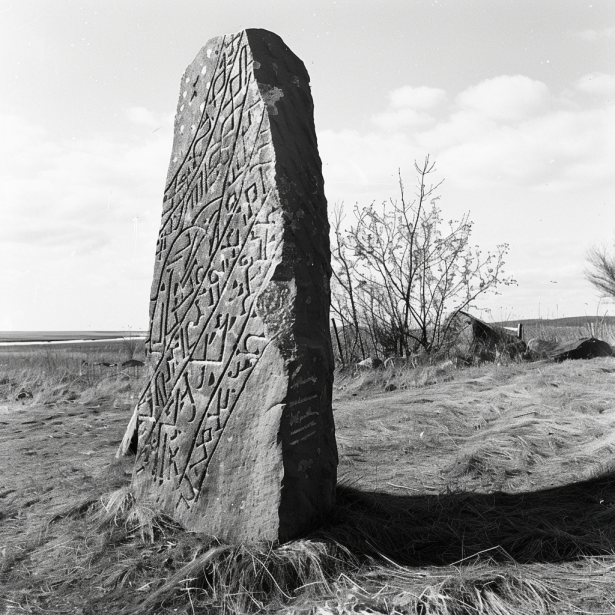Introduction
The Kensington Runestone is a controversial artifact that has puzzled historians and archaeologists since its discovery in 1898. Unearthed by Swedish-American farmer Olof Ohman near Kensington, Minnesota, the stone tablet bears an inscription in runic characters, which allegedly date back to the 14th century. According to the inscription, Scandinavian explorers visited the area in 1362, long before Columbus’s arrival in the New World. While some believe the stone to be genuine evidence of early European exploration of North America, others argue it is a modern hoax. The debate over the Kensington Runestone’s authenticity continues to this day, making it one of America’s most intriguing archaeological mysteries.
Discovery of the Kensington Runestone
Olof Ohman’s Find
In 1898, Olof Ohman discovered the Kensington Runestone while clearing land on his farm near Kensington, Minnesota. The stone, measuring approximately 30 inches high, 16 inches wide, and 6 inches thick, was found entangled in the roots of a tree. Ohman, of Swedish descent, initially did not recognize the significance of the artifact.
The Inscription
The runestone features an inscription in Old Norse runes. The translated text reads:
“8 Goths and 22 Norwegians on an exploration journey from Vinland to the west. We had camp by 2 skerries one day’s journey north from this stone. We were out and fished one day. After we came home, found 10 men red with blood and dead. AVM (Ave Maria) save us from evil. We have 10 of our party by the sea to look after our ships 14 days’ journey from this island. Year 1362.”
Arguments for Authenticity
Linguistic Analysis
Proponents of the runestone’s authenticity argue that the linguistic features of the inscription match those of 14th-century Old Norse. They highlight the use of certain runes and grammatical forms that were in use during that period but had fallen out of use by the time of the stone’s discovery.
Historical Context
Supporters suggest that the Kensington Runestone could be evidence of Scandinavian explorers, possibly Norse Greenlanders, who ventured into the interior of North America. This theory aligns with other historical accounts of Norse exploration, such as the Vinland sagas, which describe Norse voyages to North America around the 11th century.
Geological and Weathering Studies
Some geological studies have indicated that the weathering patterns on the stone’s surface and within the inscribed runes could be consistent with several centuries of exposure. These findings suggest that the stone could indeed be older than a 19th-century forgery.
Arguments Against Authenticity
Anachronistic Language
Critics argue that the inscription contains anachronistic language and runic forms that were not in use during the 14th century. They point to certain runes and linguistic elements that appear to be modern or inconsistent with known historical usage.
Lack of Corroborating Evidence
Skeptics highlight the absence of other archaeological evidence supporting the presence of 14th-century Scandinavian explorers in the region. Unlike confirmed Norse sites in Newfoundland, such as L’Anse aux Meadows, there are no additional artifacts or settlements in Minnesota to substantiate the runestone’s claims.
Olof Ohman’s Background
Detractors often point to Olof Ohman’s Scandinavian heritage and the timing of the discovery during a period of increased interest in Viking history in America. They suggest that Ohman, whether intentionally or unintentionally, could have been involved in creating a hoax to gain attention or for other motives.
Scientific and Scholarly Investigations
Early Studies
The Kensington Runestone was first examined by scholars shortly after its discovery. Initial assessments were divided, with some experts expressing cautious interest and others outright dismissing it as a forgery.
Modern Analysis
In recent decades, more advanced techniques have been applied to study the stone. These include geological analysis, 3D imaging of the runes, and detailed linguistic studies. Despite these efforts, consensus remains elusive, with new findings often fueling further debate rather than resolving the issue.
Cultural Impact and Legacy
Local and Popular Interest
The Kensington Runestone has become a cultural icon in Minnesota and beyond. It is housed in the Runestone Museum in Alexandria, Minnesota, where it attracts numerous visitors and continues to spark interest and curiosity.
Influence on Literature and Media
The runestone has inspired numerous books, articles, and documentaries, contributing to its enduring mystique. It has become a focal point in discussions about pre-Columbian trans-oceanic contact theories and the possibility of early European exploration of North America.
Conclusion
The Kensington Runestone remains one of the most intriguing archaeological mysteries in American history. Its potential as evidence of 14th-century Scandinavian explorers in North America is both tantalizing and contentious. Despite extensive research and analysis, the debate over its authenticity continues, reflecting the complexities and challenges of interpreting historical artifacts. Whether a genuine relic of a forgotten expedition or an elaborate hoax, the Kensington Runestone continues to captivate and challenge our understanding of the past.
FAQs
What is the Kensington Runestone?
The Kensington Runestone is a stone tablet discovered in 1898 near Kensington, Minnesota, bearing an inscription in runic characters that allegedly date back to the 14th century.
Who discovered the Kensington Runestone?
The runestone was discovered by Swedish-American farmer Olof Ohman while clearing land on his farm.
What does the inscription on the Kensington Runestone say?
The inscription describes a group of Scandinavian explorers who visited the area in 1362 and encountered tragedy, including the death of 10 men.
Why is the authenticity of the Kensington Runestone debated?
The authenticity is debated due to linguistic inconsistencies, lack of corroborating archaeological evidence, and suspicions of a possible hoax by the discoverer.
What are some arguments for the runestone’s authenticity?
Arguments for authenticity include linguistic features consistent with 14th-century Old Norse, historical context of Norse exploration, and geological studies suggesting long-term weathering.
What are some arguments against the runestone’s authenticity?
Arguments against authenticity include anachronistic language, absence of additional supporting evidence, and suspicions about Olof Ohman’s motives and background.

